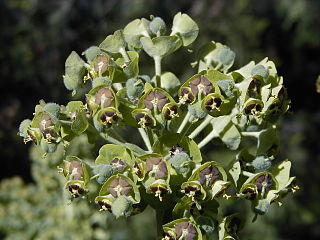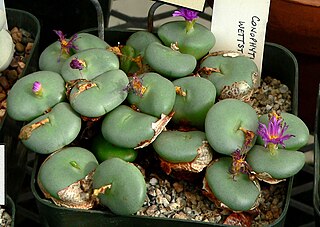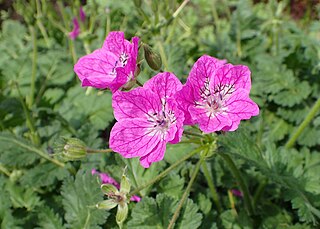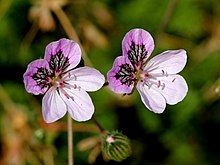
Eschscholzia californica, the California poppy, golden poppy, California sunlight or cup of gold, is a species of flowering plant in the family Papaveraceae, native to the United States and Mexico. It is cultivated as an ornamental plant flowering in summer, with showy cup-shaped flowers in brilliant shades of red, orange and yellow. It is also used as food or a garnish. It became the official state flower of California in 1903.

Commonly known as hellebores, the Eurasian genus Helleborus consists of approximately 20 species of herbaceous or evergreen perennial flowering plants in the family Ranunculaceae, within which it gave its name to the tribe of Helleboreae. Despite names such as "winter rose", "Christmas rose" and "Lenten rose", hellebores are not closely related to the rose family (Rosaceae). Many hellebore species are poisonous.

Agave parryi, known as Parry's agave or mescal agave, is a flowering plant in the family Asparagaceae, subfamily Agavoideae. It is a slow-growing succulent perennial native to Arizona, New Mexico, and northern Mexico.

Armeria maritima, the thrift, sea thrift or sea pink, is a species of flowering plant in the family Plumbaginaceae. It is a compact evergreen perennial which grows in low clumps and sends up long stems that support globes of bright pink flowers. In some cases purple, white or red flowers also occur. It is a popular garden flower and has been distributed worldwide as a garden and cut flower. It does well in gardens designed as xeriscapes or rock gardens. The Latin specific epithet maritima means pertaining to the sea or coastal.

Erodium is a genus of flowering plants in the botanical family Geraniaceae. The genus includes about 60 species, native to North Africa, Indomalaya, the Middle East, and Australia. They are perennials, annuals, or subshrubs, with five-petalled flowers in shades of white, pink, and purple, that strongly resemble the better-known Geranium (cranesbill). Cultivated plants are known as filarees or heron's bill in North America, whereas in the British Isles they are usually called storksbills.

Phebalium is a genus of thirty species of shrubs or small trees in the family Rutaceae and is endemic to Australia. The leaves are arranged alternately, simple and often warty, the flowers arranged singly or in umbels on the ends of branchlets or in leaf axils, usually with five sepals, five petals and ten stamens. There are about thirty species and they are found in all Australian states but not in the Northern Territory.

Mahonia oiwakensis is a species of plant in the barberry family, Berberidaceae. It is native to Taiwan, China and Myanmar, where it occurs at elevations of 600 to 3800 m. It has recently been found naturalized in South Africa.

Erodium cygnorum is a species of herb native to Australia.

Euphorbia characias, the Mediterranean spurge or Albanian spurge, is a species of flowering plant in the family Euphorbiaceae typical of the Mediterranean vegetation. It is an upright, compact evergreen shrub growing to 1.2 m tall and wide.

Phebalium glandulosum, commonly known as desert phebalium, is a species of shrub that is endemic to eastern Australia. It has glandular-warty stems covered with silvery to rust-coloured scales, wedge-shaped leaves that are scaly on the lower surface, and yellow flowers arranged in umbels on the ends of branchlets.

Rhamnus alaternus is a species of flowering plant in the buckthorn family Rhamnaceae, known by the common names Italian buckthorn or Mediterranean buckthorn. It is a hardy medium-sized evergreen shrub with fragrant flowers.

Veronica austriaca, the broadleaf speedwell, large speedwell, Austrian speedwell, or saw-leaved speedwell, is a species of flowering plant in the plantain family Plantaginaceae, native to northern temperate Europe. Growing to 90 cm (35 in) tall by 60 cm (24 in) broad, it is a mound-forming herbaceous perennial, with deeply toothed leaves and erect spikes of bright blue flowers throughout summer.

Genista sagittalis, called the arrow-jointed broom and winged broom, is a species of flowering plant in the genus Genista, native to central and southern Europe, Ukraine, and Anatolia. Its subspecies Genista sagittalis subsp. delphinensis, called rock broom, has gained the Royal Horticultural Society's Award of Garden Merit.
Cyananthus microphyllus, called the small-leaved bluebell-flower, is a species of flowering plant in the genus Cyananthus, native to the western Himalayas, Nepal, and Tibet. It has gained the Royal Horticultural Society's Award of Garden Merit.

Conophytum pellucidum, called the transparent cone plant, is a species of flowering plant in the genus Conophytum, native to the western Cape Provinces of South Africa. It has gained the Royal Horticultural Society's Award of Garden Merit.

Conophytum wettsteinii is a species of flowering plant in the genus Conophytum, native to the northwest Cape Provinces of South Africa. It has gained the Royal Horticultural Society's Award of Garden Merit.

Clematis tangutica, the golden clematis, is a species of flowering plant in the family Ranunculaceae. It is found from Central Asia through to most of China, and it has been introduced to western Canada, Czechia, Slovakia, Switzerland, and the South Island of New Zealand. Its cultivars 'Bill MacKenzie' and 'Lambton Park', both members of the Tangutica Group, have gained the Royal Horticultural Society's Award of Garden Merit.

Erodium manescavi, called the garden stork's-bill, large purple storksbill, Manescau storksbill, Manescau heronsbill and showy heron's bill, is a species of flowering plant in the family Geraniaceae. It is native to the Pyrenees mountains of France, and has been introduced to Austria. As Erodium manescavii it has gained the Royal Horticultural Society's Award of Garden Merit.

Disocactus speciosus, the sun cactus, is a species of flowering plant in the family Cactaceae. It is native to Mexico, Honduras and Guatemala, and has been introduced to the Canary Islands. As its synonym Heliocereus speciosus it has gained the Royal Horticultural Society's Award of Garden Merit.

Erodium chrysanthum, the yellow heron's bill, is a species of flowering plant in the family Geraniaceae, native to central and southern Greece. The flowers are a pale yellow, or rarely a pale pink. A dioecious perennial, it cultivation it is hardy in USDA zones 6 through 8, and is recommended for rock gardens, trough gardens, and borders.



















